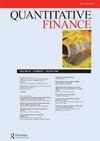小心帽子!赫斯顿随机波动模型中的约束投资组合优化
IF 1.4
4区 经济学
Q3 BUSINESS, FINANCE
引用次数: 0
摘要
摘要在赫斯顿随机波动模型中,考虑效用最大化投资者的投资组合优化问题。利用已有的对偶方法,得到了投资组合最优配置的封闭表达式。在此过程中,我们观察到,在赫斯顿的随机波动率模型中,配置约束影响最优约束投资组合配置的方式与在布莱克·斯科尔斯模型中完全不同。特别是,最优约束投资组合可能不同于朴素的“封顶”投资组合,后者在约束的边界处封顶了最优无约束投资组合。尽管存在这种差异,但我们通过数值分析的方式说明,在大多数现实情况下,与最优约束投资组合相比,上限投资组合导致的年度财富当量损失较小。然而,在金融危机期间,有上限的解决方案可能会导致令人信服的年度财富等值损失。关键词:投资组合优化配置约束动态规划heston随机波动模型不完全市场jel分类:G11C61披露声明作者未报告潜在利益冲突请注意,正如Korn和Kraft (Citation2004)所指出的那样,获得并正式验证候选投资组合过程的最优性不仅仅需要相关HJB PDE的解决方案由于任意π∈Λ只能取有限值L[0,T]⊗Q-a.s。我们不需要区分(−∞,β]和[−∞,β]或[α,∞)和(α,∞)对于任何−∞≤α,β≤∞。3从技术上讲,我们可以通过在Z−,Z0和Z+区域中花费的时间来表示“没有爆炸”,从而不那么严格地表述这一假设。但是,由于这将使演示变得非常复杂,而不会增加主要的额外见解,因此在此省略如果ρ=0所有这些跃迁时间都是无穷大对Z−,Z0和Z+区域和方程(B6)使用类似的分离,也可以从引理2.1.6中确定a的封闭形式表达式(方程(Equation18(18) b1−bη(κρσ+η2)<κ22σ2,(18))对应于假设2.4的第(i)部分。在Kraft (Citation2005)的设定中,假设2.4的(ii)部分也隐含在(Equation18(18) b1−bη(κρσ+η2)<κ22σ2,(18))中,因此不必明确提及请注意,这与经典的均值-方差优化不同,其中终端投资组合财富v0,π(T)的方差是受约束的Q.ai (Citation2022)报告称,标准普尔500指数熊市(定义为跌幅超过20%的时期)的平均长度为289天由于我们在本文中专门研究功率效用函数,我们可以在不损失一般性的情况下假设WEL独立于财富如果π是确定性的,并且Jπ是Feynman-Kac PDE的唯一解,则可以使用指数仿射分析来描述Jπ在ode系统解方面的特征。如果给出了ODE的解,则WEL的Lπ(0,z0)是已知的封闭形式。我们在补充材料的引理B.6和推论B.7中提供了对这种方法的描述。在我们的研究中,我们用欧拉法近似了相应的ODE解要了解总体情况,请参考Escobar-Anel和Gschnaidtner (Citation2016)的表4。在这里,作者认为κ=3.5, σ=0.3, ρ= - 0.4的值是他们所回顾文献的“平均情况”。本文章由计算机程序翻译,如有差异,请以英文原文为准。
Mind the cap!—constrained portfolio optimisation in Heston's stochastic volatility model
AbstractWe consider a portfolio optimisation problem for a utility-maximising investor who faces convex constraints on his portfolio allocation in Heston's stochastic volatility model. We apply existing duality methods to obtain a closed-form expression for the optimal portfolio allocation. In doing so, we observe that allocation constraints impact the optimal constrained portfolio allocation in a fundamentally different way in Heston's stochastic volatility model than in the Black Scholes model. In particular, the optimal constrained portfolio may be different from the naive ‘capped’ portfolio, which caps off the optimal unconstrained portfolio at the boundaries of the constraints. Despite this difference, we illustrate by way of a numerical analysis that in most realistic scenarios the capped portfolio leads to slim annual wealth equivalent losses compared to the optimal constrained portfolio. During a financial crisis, however, a capped solution might lead to compelling annual wealth equivalent losses.Keywords: Portfolio optimisationAllocation constraintsDynamic programmingHeston's stochastic volatility modelIncomplete marketsJEL Classifications: G11C61 Disclosure statementNo potential conflict of interest was reported by the author(s).Supplemental dataSupplemental data for this article can be accessed online at http://dx.doi.org/10.1080/14697688.2023.2271223.Notes1 Note that obtaining and formally verifying the optimality of a candidate portfolio process requires more than just a solution to the associated HJB PDE, as pointed out by Korn and Kraft (Citation2004).2 As any π∈Λ can only take finite values L[0,T]⊗Q-a.s., we do not need to distinguish between (−∞,β] and [−∞,β] or [α,∞) and [α,∞] for any −∞≤α,β≤∞.3 Technically, one can formulate this assumption less restrictively by expressing ‘No Blow-Up’ in terms of the time spent in each of the zones Z−, Z0 and Z+. However, as this would significantly complicate the presentation without adding major additional insights, it is omitted here.4 If ρ=0 all of these transition times will be infinite.5 Using a similar separation with respect to the zones Z−, Z0 and Z+ and equation (B6), it is also possible to determine a closed-form expression for A from lemma 2.1.6 Equation (Equation18(18) b1−bη(κρσ+η2)<κ22σ2,(18) ) corresponds to part (i) of Assumption 2.4. In the setting of Kraft (Citation2005), part (ii) of Assumption 2.4 is also implied by (Equation18(18) b1−bη(κρσ+η2)<κ22σ2,(18) ) and so does not have to be mentioned explicitly.7 Note that this is different from classic mean-variance optimisation, where the variance of the terminal portfolio wealth Vv0,π(T) is constrained.8 Q.ai (Citation2022) reported that the average length of an S&P500 bear market (defined as a period with drawdown in excess of 20%) was 289 days.9 Since we exclusively work with power utility functions in this paper, we may without loss of generality assume that the WEL is independent of wealth.10 If π is deterministic and Jπ is the unique solution to the Feynman–Kac PDE, one can use an exponentially affine ansatz to characterise Jπ in terms of the solutions to a system of ODEs. If the ODE solutions are given, then the WEL Lπ(0,z0) is known in closed form. We provide a description of this approach in lemma B.6 and corollary B.7 in the supplementary material. In our studies, we approximated the corresponding ODE solutions by an Euler method.11 For an overview, consider e.g. table 4 in Escobar-Anel and Gschnaidtner (Citation2016). Here, the authors consider values of κ=3.5, σ=0.3, ρ=−0.4 as an ‘Average Case’ for their reviewed literature.
求助全文
通过发布文献求助,成功后即可免费获取论文全文。
去求助
来源期刊

Quantitative Finance
社会科学-数学跨学科应用
CiteScore
3.20
自引率
7.70%
发文量
102
审稿时长
4-8 weeks
期刊介绍:
The frontiers of finance are shifting rapidly, driven in part by the increasing use of quantitative methods in the field. Quantitative Finance welcomes original research articles that reflect the dynamism of this area. The journal provides an interdisciplinary forum for presenting both theoretical and empirical approaches and offers rapid publication of original new work with high standards of quality. The readership is broad, embracing researchers and practitioners across a range of specialisms and within a variety of organizations. All articles should aim to be of interest to this broad readership.
 求助内容:
求助内容: 应助结果提醒方式:
应助结果提醒方式:


